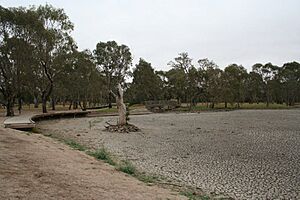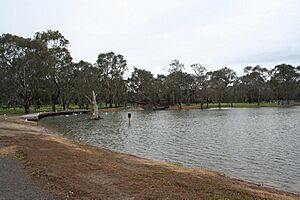Balyang Sanctuary facts for kids
Balyang Sanctuary is a lovely public park in Newtown, a suburb of Geelong, Australia. It's located right next to the Barwon River. This park is about 8 hectares (20 acres) in size and has open grassy areas, calm lakes, and important wetlands. It first opened its doors to the public in 1973. It's a great spot for enjoying nature and seeing different kinds of birds.
Contents
The Story of Balyang Sanctuary
The land where Balyang Sanctuary now sits has a long history. In 1845, a man named Captain Foster Fyans bought this land. He built his home here, calling it 'Bellbird Balyang'. This name was a way to remember a young Aboriginal person who helped him when Geelong was first being settled.
For many years, the land was mostly used for grazing animals. This was because it was low-lying and often flooded. In 1959, the local government decided to set aside this area as a public open space. The City of Newtown was in charge of buying the land. It took a few years of talks, but by 1969, the price was agreed upon.
Around the same time, in 1965, a new bridge called Princes Bridge was built. This modern bridge replaced an older wooden one. The new bridge's design created a new path that went around the area that would soon become Balyang Sanctuary.
Building the Park
Plans for the new park were approved on September 30, 1970. Work on Balyang Sanctuary began very soon after, on August 1, 1970. Some of the work was done by people who were unemployed, as part of a special program to help them find work.
The park cost about $81,500 to build. A large part of this cost, $53,350, was for the labor provided by the employment program. Balyang Sanctuary officially opened on August 16, 1973. The mayor of the City of Newtown and other government officials were there for the opening.
Park Features
When it first opened, the park had a main lake that was about 80 centimeters (2 feet 6 inches) deep. The lake had walls made of bluestone and concrete. There were three islands in the middle of the lake, and you could reach two of them by walking across four footbridges.
Water for the lake came from two storm drains and also by pumping water from the Barwon River. The park also had 150 parking spots, public toilets, and picnic tables. Many walking and bike paths connect Balyang Sanctuary to other parks along the Barwon River, making it easy to explore the area.
Wildlife at the Sanctuary
Balyang Sanctuary is home to many different kinds of birds. You can see both native Australian birds and some birds that were brought from other parts of the world. Some of the birds you might spot include swans, pelicans, Eurasian coots, dusky moorhens, Pacific black ducks, mallards, pied cormorants, geese, and silver gulls. It's a great place for birdwatching!
Balyang Sanctuary Today
In the early 2000s, people tried to remove European carp from the lake. These fish are not native to Australia and can harm the environment. However, these efforts were not successful.
Then, during a long drought in the summer of 2007, the lake completely dried up. This was a big change for the park. In early 2007, Balyang Sanctuary was updated. The bluestone edging around the lake was removed, and the lake was rebuilt to look more like a natural wetland. This helps the park's ecosystem and makes it a better home for wildlife.
Images for kids





